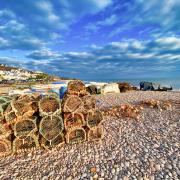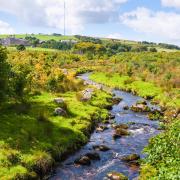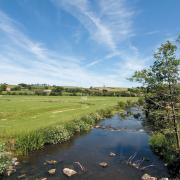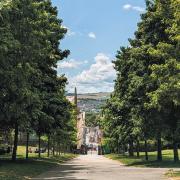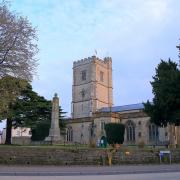Paul Meaden takes an atmospheric literary tour from Dartmoor to the Dart Valley
Beyond Einstein’s theory of relativity, time travel is considered challenging. Yet given the right location and book, I can transport myself into the past through the eyes of great writers. Nowhere is that more true than along the course of the River Dart. From the mystical heights of Dartmoor, it cascades from the high moor through bohemian Totnes before meeting the channel at historic Dartmouth.

This literary jaunt begins at Lewtrenchard Manor. Mentioned in the Domesday Book, Lewtrenchard is now a sumptuous hotel on the northern fringe of the great moor. The manor’s most famous inhabitant was Sabine Baring-Gould, who inherited it in 1881, becoming parson and squire. Best known for penning the hymn Onward Christian Soldiers, Gould was a polymath. He wrote on many diverse subjects, including Dartmoor, where his writings covered a kaleidoscope of scientific, social and cultural studies of moor life.
From the comfort of a wing-backed chair in the oak-panelled library at Lewtrenchard, you can wonder at the unimprovable beauty of Gould’s prose. The opening page of A Book of Dartmoor symbolises the moor as mother to many streams:
And what a mother! She sends them forth limpid and pure, full of laughter and leap, of flash and brawl. She does not discharge them laden with brown mud, as the Exe, nor turned by the waters of Egypt to blood, as the Creedy.
As your terrier nuzzles your feet and something amber tingles your soul, glance through the mullioned windows at the high moor. Imagine the countless miles Gould endured on horseback, transforming the drama of the moor into words as vivid as if viewed through the pre-dawn steam of his horse’s breath.

From luxurious Lewtrenchard, head to Princetown, home to brooding Dartmoor Prison. Built to incarcerate prisoners from the Napoleonic wars, the prison was home to Seddon, the brutal murderer of Conan-Doyle’s The Hound of The Baskervilles.
Having escaped prison, Seddon plays a cameo in a complex plot in which the arch-villain Stapleton - heir to the Baskerville fortune - has shackled and starved a gigantic hound at the centre of the Grimpen Mire, in preparation for a murderous attack upon Sir Henry Baskerville. Meanwhile, Holmes is secretly encamped upon the moor, keeping vigil over Baskerville and his chaperone Dr Watson.
Legend suggests the site of Holmes’ camp was Fox Tor, six miles south-east of Princetown. Fox Tor towers above the Foxtor Mires, which provided the inspiration for Grimpen Mire. From his granite hideout, Holmes solves the mystery and sets a trap for Stapleton, with some grisly fates along the way.
For those of strong constitution, Holmes’ night-time vigil can be recreated with a spot of wild camping at Fox Tor. There can be fewer sights more dramatic than sunset and sunrise from the Dartmoor plateau. That is, if you are brave enough to ignore Holmes’ warning to ‘avoid the moor in those hours of darkness when the powers of evil are exalted...’
Assuming you survive the swamps and beasts of Dartmoor, next stop is the naval town of Dartmouth - haven of the arts and sometime home to many literary personalities.

Christopher Robin Milne, son of A.A. Milne, moved to Dartmouth to escape the legacy of his portrayal in his father’s Winnie the Pooh books. Christopher ran The Harbour Bookshop, and is rumoured to have routinely hidden from American tourists, keen only to discuss the endearingly dimwitted bear.
A challenging walk along the The Dart Trail takes you to the Greenway estate, summer residence of the Queen of Crime, Agatha Christie. Greenway is a literary and horticultural experience in equal measure. Its exotic gardens conjure images of Du Maurier’s Manderlay, Cornish home of the De-Winters in the iconic Rebecca. Follow the verdant paths to the waterside, and you’ll discover the Victorian boat house, which inspired the murder scene in Dead Man’s Folly.

Take the return ferry to the sanctuary of Dartmouth, and complete your literary trek with a tot of rum in the Dartmouth Arms, alongside the ancient cobblestones of Bayard’s Cove. Gaze wistfully to sea between Kingswear and Dartmouth Castles before retiring next door to exchange the groundsheet of your Dartmoor tent for the crisp linen of nautically themed Bayards Cove Inn.
BOOKSHOP BREAK
No literary holiday is complete without a visit to a bookshop to replenish your shelves. Preferably an independent goldmine of a bookshop with friendly and knowledgeable staff. Browser Books in Foss Street, Dartmouth, is a gorgeous bolthole, owned by Clare and managed by Emily – who is also Browser’s social media guru, photographer, and artist. Emily’s hand-painted art often decorates the window display. Browser holds author events and stocks local titles as well as a selection of children’s and general fiction, natural history, history, and current affairs. Visit Foss Street as the sun retreats for the day, and be treated to a Dickensian street scene, with cobblestones shimmering in the golden glow of the shop lights. browserbooks.co.uk







